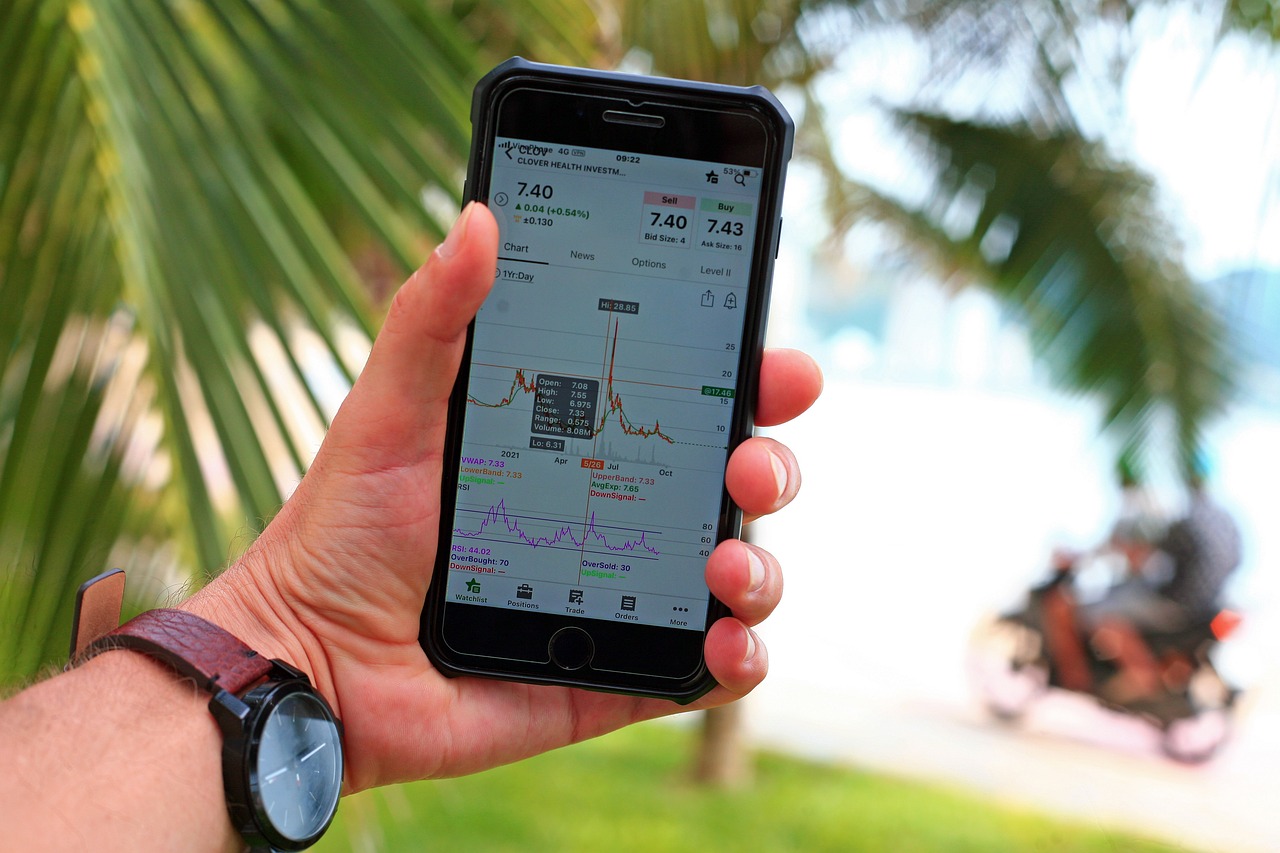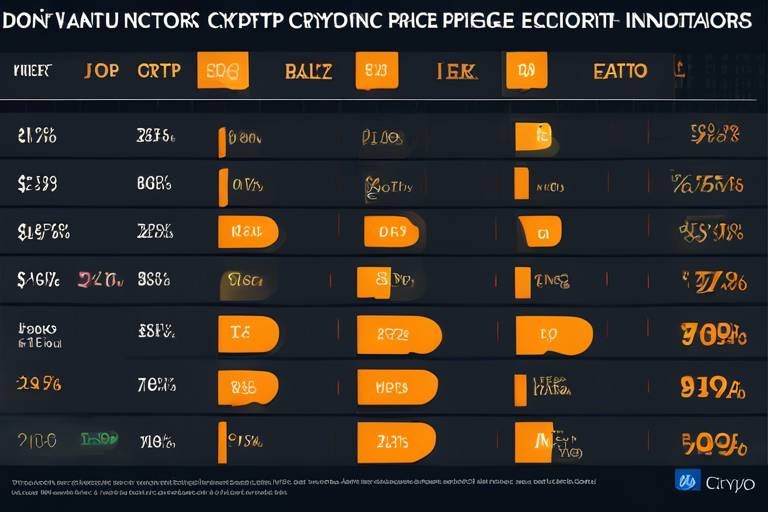How to Leverage Data Analytics in Crypto Trading
In the ever-evolving world of cryptocurrency trading, the ability to make informed decisions can set successful traders apart from the rest. With the vast amount of data generated daily, data analytics has emerged as a game-changer for traders looking to enhance their strategies and optimize investment outcomes. Imagine having a crystal ball that not only predicts market movements but also helps you understand the underlying reasons behind those movements. That’s the power of data analytics in crypto trading!
Data analytics involves the systematic analysis of data to uncover patterns, trends, and insights that can guide decision-making. In the context of crypto trading, it means diving deep into market behavior, historical data, and various metrics to make smarter, data-driven choices. By leveraging data analytics, traders can improve their trading strategies, manage risks better, and ultimately achieve better returns on their investments.
But how exactly can one leverage data analytics in this volatile market? Well, it all starts with understanding the key metrics that drive the market. For instance, metrics such as trading volume, price trends, and market sentiment are crucial. Each of these metrics provides unique insights that can help traders predict price movements and make strategic decisions.
Furthermore, utilizing technical indicators can significantly enhance trading strategies. Indicators like moving averages and the Relative Strength Index (RSI) offer valuable insights into market trends, helping traders identify the best entry and exit points. Think of these indicators as your trusty compass in the often tumultuous sea of crypto trading.
As we delve deeper into the world of data analytics, we will explore various techniques and tools that can aid in making informed trading decisions. From analyzing trading volume to understanding sentiment analysis and utilizing technical indicators, the possibilities are vast. Embracing these data-driven insights can transform your trading approach from guesswork to a calculated strategy, ultimately leading to more successful outcomes.
- What is data analytics in crypto trading? - Data analytics in crypto trading refers to the interpretation of complex data sets to identify trends and patterns that can inform trading decisions.
- Why are trading volume and market sentiment important? - Trading volume indicates market activity and liquidity, while market sentiment reflects public perception, both of which are crucial for predicting price movements.
- How can I use technical indicators in my trading strategy? - Technical indicators like moving averages and RSI can help you identify trends and potential entry/exit points, enhancing your overall trading strategy.

Understanding Data Analytics in Crypto
Data analytics is like having a superpower in the fast-paced world of cryptocurrency trading. Imagine being able to sift through mountains of data to find those hidden gems or emerging trends that can significantly impact your investment decisions. It's not just about luck; it's about using data-driven insights to guide your trading strategies. In the crypto market, where volatility reigns supreme, understanding data analytics can be the difference between making a profit or facing a loss.
At its core, data analytics involves interpreting complex data sets to uncover patterns and trends. Think of it as a treasure map that leads you to potential opportunities. By analyzing historical price movements, trading volumes, and market sentiment, traders can make informed decisions that are rooted in reality rather than speculation. This approach helps to mitigate risks and enhances the overall trading experience.
In the realm of cryptocurrency, traders face a unique set of challenges. The market is often influenced by various factors, including news events, technological advancements, and even social media trends. By leveraging data analytics, traders can gain a deeper understanding of these influences. For instance, if a particular cryptocurrency is trending on social media, it might be worth investigating how that sentiment correlates with price movements. This kind of analysis allows traders to stay one step ahead of the market.
Moreover, data analytics can help identify key metrics that are essential for successful trading. Some of the most important metrics include:
- Trading Volume: This measures the total amount of a cryptocurrency that has been traded during a specific time frame. High trading volume often indicates a strong interest in that asset.
- Price Trends: By analyzing price movements over time, traders can identify bullish or bearish trends and make predictions about future price behavior.
- Market Sentiment: Understanding how traders feel about a particular cryptocurrency can provide valuable insights into potential price movements.
By focusing on these metrics, traders can develop a comprehensive understanding of market behavior. This knowledge empowers them to make strategic trading choices that are backed by data rather than mere intuition. In a market as unpredictable as cryptocurrency, this level of insight is invaluable.
In summary, data analytics is a critical tool for anyone looking to navigate the complex waters of crypto trading. By understanding and applying data analytics, traders can enhance their decision-making processes, optimize their strategies, and ultimately improve their investment outcomes. So, whether you're a seasoned trader or just starting out, embracing data analytics could be your ticket to success in the ever-evolving world of cryptocurrency.

Key Metrics for Crypto Traders
When diving into the world of cryptocurrency trading, it’s crucial to grasp the key metrics that can make or break your trading strategy. Think of these metrics as your compass in the vast ocean of the crypto market. They guide you through the tumultuous waters, helping you navigate potential pitfalls and seize lucrative opportunities. So, what are these essential metrics that every trader should keep an eye on?
First and foremost, trading volume stands out as a vital indicator. It reflects the total number of assets traded within a specific timeframe, offering insights into market activity and liquidity. High trading volumes often signal robust interest in a cryptocurrency, hinting at potential price movements. For instance, if you see a sudden spike in volume, it might be a sign that something significant is happening in the market, urging you to investigate further.
Next up is price trends. Understanding how a cryptocurrency's price has moved over time can provide invaluable context for your trading decisions. You might ask, "How do I identify these trends?" A great way is to look at historical price charts and observe patterns. Are prices consistently rising, falling, or fluctuating? Recognizing these trends can help you anticipate future movements and make informed trading choices.
Another critical metric is market sentiment. This involves gauging the overall mood of the market participants. Are traders feeling optimistic, or is there a sense of impending doom? Tools like sentiment analysis can help you decipher this emotional landscape. By monitoring social media chatter and news articles, you can get a feel for whether the market is bullish or bearish. This insight can significantly influence your trading strategy.
To better illustrate these key metrics, let’s break them down into a table:
| Metric | Description | Importance |
|---|---|---|
| Trading Volume | Measures the total quantity of a cryptocurrency traded over a specific period. | Indicates market interest and potential price movements. |
| Price Trends | Tracks the historical price movements of a cryptocurrency. | Helps in predicting future price actions and market behavior. |
| Market Sentiment | Assesses the overall mood and feelings of traders towards a cryptocurrency. | Guides traders in making decisions based on public perception. |
In summary, mastering these key metrics can significantly enhance your trading strategies. By focusing on trading volume, price trends, and market sentiment, you’ll be well-equipped to navigate the unpredictable waters of the crypto market. Remember, the more informed you are, the better your chances of making successful trades!
- What is trading volume in crypto? Trading volume refers to the total amount of a cryptocurrency that has been traded during a specific timeframe. It helps assess the liquidity and market activity.
- How can I analyze price trends? You can analyze price trends by reviewing historical price charts and identifying patterns over time, such as upward or downward trends.
- Why is market sentiment important? Market sentiment reflects the collective feelings of traders and can influence price movements. Understanding sentiment helps you anticipate market reactions.

Trading Volume Analysis
When it comes to trading cryptocurrencies, is like having a crystal ball that reveals the market's hidden secrets. It provides critical insights into the level of activity surrounding a particular cryptocurrency, allowing traders to gauge the strength of price movements. Imagine walking into a crowded room; the buzz of conversation tells you a lot about what's happening. Similarly, trading volume indicates how much interest there is in a cryptocurrency at any given time.
High trading volume often signifies strong interest and can lead to significant price movements. For instance, if a cryptocurrency is experiencing a surge in volume, it may suggest that traders are flocking to it, potentially indicating a bullish trend. Conversely, low trading volume can be a red flag, hinting at a lack of interest or liquidity, which may lead to price stagnation or even declines. This is why understanding volume is crucial for making informed trading decisions.
To dive deeper into volume analysis, let’s explore some key aspects:
- Identifying Volume Trends: Watching how volume changes over time can reveal valuable insights. An increase in volume may signal the beginning of a new trend, while a sudden drop could foreshadow a reversal. Think of it as the tide coming in or going out; it can dramatically affect what happens on the shore.
- Volume and Price Correlation: There’s a significant relationship between trading volume and price movements. A price increase that coincides with high volume often confirms the strength of the trend. On the flip side, if prices rise but volume is low, it might suggest that the trend lacks support and could be short-lived.
Here's a simple table that illustrates the relationship between trading volume and price movements:
| Volume Level | Price Movement | Market Sentiment |
|---|---|---|
| High | Upward Trend | Positive |
| Low | Stagnant or Downward Trend | Negative |
| Increasing | Potential Bullish Trend | Optimistic |
| Decreasing | Potential Bearish Trend | Pessimistic |
In summary, trading volume analysis is an essential tool for any crypto trader. It helps in identifying potential trading opportunities and understanding market dynamics. By keeping an eye on volume trends and their correlation with price movements, traders can make more informed decisions, ultimately optimizing their investment strategies. So, the next time you analyze a cryptocurrency, don’t just look at the price—pay attention to the volume, and you might just uncover the next big opportunity!
1. What is trading volume?
Trading volume refers to the total number of shares or contracts traded for a specific cryptocurrency during a given time period. It is a key indicator of market activity.
2. Why is trading volume important?
Trading volume is important because it provides insights into market liquidity and trader interest. High volume often indicates strong price movements, while low volume can signal stagnation.
3. How can I analyze trading volume?
You can analyze trading volume by looking at historical volume data, identifying trends over time, and correlating volume changes with price movements. Tools like charts and indicators can help visualize this data.
4. What should I do if I see low trading volume?
If you see low trading volume, it may be wise to exercise caution. Low volume can indicate a lack of interest, and price movements might be unreliable. It’s often better to wait for volume to increase before making significant trades.

Identifying Volume Trends
Identifying volume trends is like reading the pulse of the cryptocurrency market. Just as a doctor checks your heartbeat to assess your health, traders analyze volume trends to gauge market vitality. When you notice a significant increase in trading volume, it often indicates a surge of interest in a particular cryptocurrency. This surge can signal the beginning of a bullish trend, where prices are likely to rise. Conversely, when volume begins to dwindle, it may suggest that traders are losing interest, hinting at a potential bearish reversal.
To effectively identify these trends, traders can utilize various analytical tools and platforms that provide real-time data. By observing historical volume patterns, traders can spot recurring trends and make educated predictions about future movements. For example, if a cryptocurrency has consistently shown rising volume during certain times of the day or week, this knowledge can be leveraged to time trades more effectively.
Moreover, understanding the context behind volume changes is crucial. For instance, if a cryptocurrency experiences a sudden spike in volume due to positive news or a major partnership announcement, it may lead to a price increase. On the other hand, if the volume spikes but the price remains stagnant or drops, it could indicate that the market is reacting to negative news or uncertainty. Thus, volume trends should always be analyzed in conjunction with other market indicators.
Here’s a quick table summarizing how to interpret volume trends:
| Volume Trend | Market Implication |
|---|---|
| Increasing Volume | Potential bullish trend; strong interest in the asset |
| Decreasing Volume | Possible bearish reversal; waning trader interest |
| High Volume with Price Increase | Confirmation of trend strength |
| High Volume with Price Decrease | Market uncertainty or negative sentiment |
In conclusion, recognizing volume trends is an essential skill for crypto traders. By keeping a keen eye on these fluctuations, you can better position yourself to capitalize on market opportunities. Remember, the more informed you are, the better your chances of making successful trades.
- What is trading volume? Trading volume refers to the total number of shares or contracts traded for a specific asset during a given period. It’s a key indicator of market activity.
- How can I track volume trends? You can track volume trends using various trading platforms and analytical tools that provide real-time data and historical volume charts.
- Why is volume important in crypto trading? Volume is important because it helps traders understand market momentum, assess liquidity, and confirm price movements.
- What should I do if I see a sudden spike in volume? Investigate the reason behind the spike. It could be due to news, events, or market sentiment changes. Adjust your trading strategy accordingly.

Volume and Price Correlation
Understanding the relationship between trading volume and price movements is crucial for any crypto trader looking to make informed decisions. When we talk about volume, we're referring to the total amount of a cryptocurrency that is traded within a specific timeframe. This metric can provide valuable insights into the strength or weakness of a price trend. For instance, if a cryptocurrency's price is increasing and is accompanied by high trading volume, it often indicates that the price movement is supported by strong buying interest, reinforcing the trend's legitimacy.
Conversely, if prices rise but the volume is low, it may suggest a lack of conviction among traders, which could lead to a potential reversal. Think of it this way: high volume during a price increase is like a roaring crowd at a concert, cheering on the performance. In contrast, low volume is akin to a handful of people clapping politely; it may not be enough to sustain the excitement for long. Therefore, recognizing these patterns can be pivotal in deciding when to enter or exit trades.
Moreover, the correlation between volume and price can be summarized in a few key points:
- High Volume with Price Increase: This scenario typically confirms a strong bullish trend, suggesting continued upward momentum.
- High Volume with Price Decrease: This often indicates strong selling pressure, which may lead to further declines.
- Low Volume with Price Increase: This is a red flag; it often signals a potential reversal or correction.
- Low Volume with Price Decrease: This can imply a lack of interest in selling, which may stabilize the price.
To further illustrate this correlation, consider the following table that outlines hypothetical trading scenarios:
| Scenario | Volume Level | Price Movement | Implication |
|---|---|---|---|
| 1 | High | Increasing | Strong bullish trend |
| 2 | High | Decreasing | Strong bearish trend |
| 3 | Low | Increasing | Potential reversal |
| 4 | Low | Decreasing | Price stabilization |
In conclusion, recognizing the correlation between volume and price movements is not just about numbers; it's about understanding the market's pulse. By keeping a close eye on these indicators, traders can make more informed decisions, enhancing their chances of success in the volatile world of cryptocurrency trading.
- What is the significance of trading volume in crypto? Trading volume indicates the level of activity and interest in a cryptocurrency, helping traders gauge potential price movements.
- How can I analyze volume trends? Traders can analyze volume trends by observing changes over time, comparing it with price movements, and utilizing analytical tools.
- What are the best practices for using volume in trading strategies? Combining volume analysis with other technical indicators, and being aware of market sentiment can enhance trading strategies.

Sentiment Analysis Techniques
When it comes to trading cryptocurrencies, understanding market sentiment can be a game changer. Sentiment analysis is like having a crystal ball that reveals the emotions driving the market. By examining social media chatter, news articles, and even forum discussions, traders can gauge whether the market is feeling bullish or bearish. This approach is particularly vital in the highly volatile world of crypto, where a single tweet can send prices soaring or plummeting.
One of the most effective ways to conduct sentiment analysis is by utilizing social media platforms. Twitter, for example, is a treasure trove of real-time opinions. By monitoring hashtags related to specific cryptocurrencies, traders can quickly assess the general mood surrounding a coin. Are people excited about an upcoming project? Or are they expressing doubts? This information can provide crucial insights into potential price movements.
Moreover, sentiment analysis tools have emerged that automate this process, providing traders with a comprehensive overview of public sentiment. These tools use algorithms to analyze vast amounts of data from various sources, presenting it in an easily digestible format. For instance, a tool might display a sentiment score ranging from -1 to +1, where negative values indicate bearish sentiment and positive values suggest bullish sentiment. This can help traders make informed decisions about when to enter or exit a trade.
Another technique involves analyzing news sentiment. Major news outlets often cover significant events related to cryptocurrencies, such as regulatory changes or technological advancements. By assessing the tone of these articles—whether they are positive, negative, or neutral—traders can gain insight into how the market might react. For instance, if a well-respected publication publishes a favorable article about a cryptocurrency, it could lead to increased buying activity.
To illustrate the importance of sentiment analysis, let’s look at a hypothetical scenario:
| Event | Market Sentiment | Expected Price Movement |
|---|---|---|
| Positive news about Bitcoin's adoption by a major retailer | Bullish | Price likely to rise |
| Negative regulatory news affecting altcoins | Bearish | Price likely to fall |
| General market panic due to a sudden drop | Fearful | Potential for a sell-off |
In this table, you can see how different events can influence market sentiment and, consequently, price movements. By staying attuned to these emotional undercurrents, traders can better position themselves to capitalize on market opportunities.
In summary, sentiment analysis is not just about understanding what people are saying; it's about interpreting how those sentiments can influence market behavior. By leveraging social media insights, news sentiment, and automated tools, traders can gain a competitive edge in the ever-changing landscape of cryptocurrency trading.
- What is sentiment analysis in crypto trading?
Sentiment analysis in crypto trading refers to the process of evaluating public opinion and emotional reactions towards cryptocurrencies through various data sources like social media and news articles. - How can I perform sentiment analysis?
You can perform sentiment analysis by monitoring social media platforms, using sentiment analysis tools, and analyzing the tone of news articles related to cryptocurrencies. - Why is sentiment analysis important?
Sentiment analysis is crucial because it helps traders anticipate market movements based on public emotions, allowing them to make more informed trading decisions. - Are there tools for sentiment analysis?
Yes, there are several tools available that automate sentiment analysis by analyzing data from social media and news sources to provide sentiment scores and insights.

Utilizing Technical Indicators
When it comes to navigating the turbulent waters of cryptocurrency trading, having a reliable compass is crucial. This is where technical indicators come into play. They are like the GPS for traders, guiding them through the maze of price fluctuations and market sentiments. By utilizing these indicators, traders can make more informed decisions, enhancing their overall trading strategies.
Technical indicators are mathematical calculations based on historical price, volume, or open interest of a security. They help traders identify patterns, trends, and potential reversals in the market. Think of them as a set of tools in a trader's toolbox. Just as a carpenter wouldn't build a house without a hammer or a saw, a trader shouldn't enter the market without understanding how to use technical indicators effectively.
Some of the most popular technical indicators include:
- Moving Averages (MA): These indicators smooth out price data to help identify trends over specific periods. They can be simple (SMA) or exponential (EMA), each serving its unique purpose in analyzing price movements.
- Relative Strength Index (RSI): This momentum oscillator measures the speed and change of price movements. It helps traders identify whether an asset is overbought or oversold, which can indicate potential price reversals.
- Bollinger Bands: These bands consist of a middle band (the moving average) and two outer bands that represent volatility. They help traders assess whether prices are high or low on a relative basis.
Using these indicators effectively can significantly enhance trading strategies. For example, a trader might use a moving average to determine the overall trend and the RSI to identify entry points. If the moving average indicates a bullish trend while the RSI shows oversold conditions, it could be a prime opportunity to buy.
However, it's important to remember that no single indicator is foolproof. Just like a weather forecast, technical indicators provide probabilities rather than certainties. Therefore, combining multiple indicators can provide a more comprehensive view of the market, allowing traders to make better-informed decisions. For instance, a trader might look at both the RSI and moving averages simultaneously to confirm a trading signal.
In conclusion, utilizing technical indicators is not just about following numbers and charts. It's about understanding the underlying market dynamics and using that knowledge to your advantage. By incorporating these tools into your trading strategy, you can navigate the complexities of the crypto market with greater confidence and precision.
Q1: What are technical indicators?
A1: Technical indicators are mathematical calculations based on historical price, volume, or open interest of a security. They help traders identify patterns, trends, and potential reversals in the market.
Q2: How do I choose the right technical indicators?
A2: The right indicators depend on your trading strategy. It's often beneficial to combine several indicators to get a comprehensive view of market conditions.
Q3: Can technical indicators guarantee successful trades?
A3: No, technical indicators cannot guarantee success. They provide probabilities and insights, but market conditions can change rapidly, and it's essential to use them in conjunction with other analysis methods.

Moving Averages Explained
When it comes to navigating the often turbulent waters of cryptocurrency trading, moving averages serve as a lighthouse guiding traders through the fog of price fluctuations. Essentially, a moving average is a statistical calculation used to analyze data points by creating averages over a specific period. This technique helps to smooth out price data, allowing traders to identify trends more clearly. Think of it as filtering out the noise—like tuning a radio to get a clearer signal amidst the static.
There are several types of moving averages, but the two most commonly used in crypto trading are the Simple Moving Average (SMA) and the Exponential Moving Average (EMA). The SMA calculates the average price over a specified number of periods, providing a straightforward view of price trends. On the other hand, the EMA gives more weight to recent prices, making it more responsive to new information. This responsiveness can be crucial in the fast-paced world of cryptocurrencies, where market sentiment can shift rapidly.
To illustrate how moving averages can impact trading decisions, consider the following table:
| Type of Moving Average | Calculation Method | Best Use Case |
|---|---|---|
| Simple Moving Average (SMA) | Average of closing prices over a specific number of periods | Identifying long-term trends |
| Exponential Moving Average (EMA) | Weighted average that gives more importance to recent prices | Spotting short-term trends and reversals |
One of the most powerful ways to use moving averages is by implementing crossover strategies. A crossover occurs when a shorter-term moving average crosses above or below a longer-term moving average. For instance, if the 50-day EMA crosses above the 200-day EMA, it can be a signal to buy, indicating a potential bullish trend. Conversely, if the 50-day EMA crosses below the 200-day EMA, it might suggest a bearish trend, prompting traders to sell.
Moreover, moving averages can also serve as dynamic support and resistance levels. When the price of a cryptocurrency approaches a moving average, it can either bounce off it or break through, providing traders with valuable entry and exit points. This dynamic nature of moving averages adds another layer of strategy to trading, making them an essential tool in any trader's arsenal.
In summary, understanding moving averages is crucial for any cryptocurrency trader looking to enhance their trading strategies. By effectively utilizing both SMA and EMA, traders can gain insights into market trends, make informed decisions, and ultimately improve their investment outcomes. So, the next time you find yourself staring at a price chart, remember that moving averages might just be the compass you need to navigate the crypto seas.
- What is the main purpose of using moving averages in trading? Moving averages help traders identify trends and potential entry or exit points by smoothing out price data.
- How do I choose between SMA and EMA? SMA is better for long-term trends, while EMA is more suitable for short-term trading due to its responsiveness to recent price changes.
- Can moving averages predict price movements? While moving averages can provide insights into trends, they are not foolproof and should be used in conjunction with other indicators and analysis techniques.

Relative Strength Index (RSI)
The is a powerful tool in the arsenal of any crypto trader. Developed by J. Welles Wilder Jr. in the late 1970s, this momentum oscillator is designed to measure the speed and change of price movements. Essentially, the RSI provides insights into whether a cryptocurrency is overbought or oversold, which can be crucial for making timely trading decisions. But how exactly does it work, and why should you incorporate it into your trading strategy?
The RSI operates on a scale of 0 to 100, with levels typically set at 30 and 70 to signify oversold and overbought conditions, respectively. When the RSI crosses above 70, it indicates that a cryptocurrency may be overbought, suggesting that a price correction could be imminent. Conversely, an RSI reading below 30 indicates that the asset may be oversold, potentially signaling a buying opportunity. This simple yet effective approach can help traders identify optimal entry and exit points.
Understanding the nuances of the RSI can enhance your trading strategy significantly. Here are some key aspects to consider:
- Period Selection: The default setting for the RSI is a 14-day period, but traders often adjust this based on their trading style. Shorter periods can lead to more signals but may also increase noise, while longer periods smooth out fluctuations and provide a clearer trend.
- Divergence: One of the most insightful aspects of the RSI is its ability to indicate divergence. If the price of a cryptocurrency is making new highs while the RSI is failing to reach new highs, it suggests a potential reversal. This divergence can be a powerful signal for traders looking to capitalize on market corrections.
- Combining with Other Indicators: The RSI is most effective when used in conjunction with other technical indicators. For example, pairing the RSI with moving averages can provide additional confirmation of a trend, enhancing the reliability of your trading decisions.
To illustrate the effectiveness of the RSI, consider the following table that summarizes typical RSI trading signals:
| RSI Level | Market Condition | Trading Action |
|---|---|---|
| Above 70 | Overbought | Consider selling or taking profits |
| Below 30 | Oversold | Consider buying or entering a position |
| Between 30 and 70 | Neutral | Hold position or wait for clearer signals |
In summary, the RSI is not just a number; it's a window into market sentiment and potential future movements. By integrating the RSI into your trading strategy, you can make more informed decisions that align with market dynamics. Remember, though, that no indicator is foolproof. It's essential to combine the RSI with other analyses and maintain a disciplined trading approach.
- What is the best period for the RSI? While the default is 14 days, many traders adjust this based on their specific trading style and market conditions.
- Can the RSI be used for day trading? Absolutely! Day traders often use shorter periods for the RSI to capture quick price movements.
- Is the RSI effective in all market conditions? The RSI is a versatile tool, but its effectiveness can vary. It's best used in conjunction with other indicators and market analysis.
Frequently Asked Questions
-
What is data analytics in crypto trading?
Data analytics in crypto trading refers to the process of interpreting and analyzing complex data sets to uncover patterns, trends, and insights that can inform trading decisions. By leveraging historical data and market behavior, traders can make more informed choices, potentially leading to better investment outcomes.
-
Why are key metrics important for crypto traders?
Key metrics, such as trading volume, price trends, and market sentiment, are crucial for crypto traders as they provide valuable insights into market dynamics. Understanding these metrics helps traders predict price movements, identify potential trading opportunities, and develop effective trading strategies.
-
How can I analyze trading volume?
To analyze trading volume, traders can monitor the amount of cryptocurrency traded over a specific period. High trading volume often indicates strong interest and potential price movements, while recognizing trends in volume can help anticipate market shifts, such as bullish or bearish reversals.
-
What is sentiment analysis and how is it used in crypto trading?
Sentiment analysis evaluates the emotions and opinions of market participants by analyzing data from social media, news articles, and forums. By gauging public sentiment, traders can anticipate market reactions and adjust their strategies accordingly, helping them to stay ahead of potential price movements.
-
What are technical indicators and why are they important?
Technical indicators, such as moving averages and the Relative Strength Index (RSI), are mathematical calculations based on price and volume data. They are important because they provide traders with insights into market trends, helping them to identify entry and exit points, and ultimately improve their trading strategies.
-
How do moving averages help in trading?
Moving averages help traders by smoothing out price data over a specific period, making it easier to identify trends. They can indicate potential support and resistance levels, guiding traders in determining when to enter or exit a trade based on the overall market direction.
-
What does the Relative Strength Index (RSI) indicate?
The RSI is a momentum oscillator that measures the speed and change of price movements. It ranges from 0 to 100 and helps traders identify overbought or oversold conditions in the market, which can signal potential reversals or continuation of trends, aiding in more informed trading decisions.



















